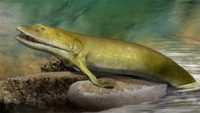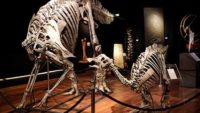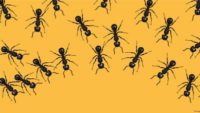Have chemical evolutionists proven that life could have evolved from non-living chemicals in hydrothermal vents? …read more Source: creation.com
A piece of string about 6 millimeters long is threatening standard evolutionary theory about the history of humanity. The BBC reported that researchers from the United States, France, and Spain recently discovered a small piece of string at a Neanderthal site in France.1 The researchers say that the string is approximately 50,000 years old. According to evolutionary theory, Neanderthals were a relatively r… More… …read more Source: icr.org
How termites reflect the glory of their Creator. …read more Source: creation.com
Biological systems that allow organisms to function, grow, and adapt bear the hallmarks of being exquisitely engineered. These complex systems exhibit the same design principles that human engineers use to create successful machines and devices. Now, a new study has just been published that reveals part of the amazing internal signaling and communication scheme that plants use to synchronize their circadian clocks between shoots and roots.1More… …read more Source: icr.org
Spiders use electric fields in the atmosphere to help them get airborne …read more Source: creation.com
The complexities of turning a non-biped ape into something that walks bipedally appears to be totally ignored by evolutionists when they peddle their just-so stories. …read more Source: creation.com
In today’s change-filled world, God is ubiquitously displaying His creativity to provide for our most important needs. God’s creative providence fulfills what we need to solve the challenging problems of daily living. Something similar is exhibited in the world of nature. Creatures are built with traits that adapt to the situations that surround them. The Eurasian Woodcock (Scolopax rusticola) looks like a skin… More… …read more Source: icr.org
Is it ok for humans to modify organisms? What about human-animal hybrids? We discuss the biblical and ethical guidelines for Christians in today’s world of rapidly developing biotechnology. …read more Source: creation.com
Neanderthals are classified by evolutionists as archaic humans given that both their DNA and bones are essentially human. Yet, new stories constantly hit the headlines with the supposedly shocking news that anatomically modern humans and Neanderthals were found to have interbred once again. Recently, another such story appeared in the journal Genetics.1 Why is this type of news so exciting, yet also so confusing to ev… More… …read more Source: icr.org
High-speed creature communication has been making the news recently. There was underwater research on deep-sea squid,1 and now bird communication. In fact, the rapid signaling discovered in the honeyeater bird is all part of an intricate multi-part message that has scientists in awe at both its rapidity and complexity.2 The honeyeaters are a large and diverse family of small to medium sized birds mostly found … More… …read more Source: icr.org
Now is the season—late March and April—for bluebonnets to blossom in Texas!1 Establishing these beautiful flowers is difficult, as many have learned. But that difficulty is itself telltale evidence of God’s bioengineering care, because those flowers need much more than luck to succeed! Consider the lilies of the field, how they grow; they neither toil nor spin; and yet… More… …read more Source: icr.org
Where did disease-causing viruses come from? …read more Source: creation.com
By Ken Ham With our fingers we can type on a keyboard, play notes on a piano, and sketch a detailed landscape. Whom do we have to thank for these nimble appendages? Well, according to a recent news item, we can express our thanksgiving to . . . an extinct fish! “Thank This Fish for Your Fingers” Researchers recently reported the discovery and analysis of a nearly complete (yet poorly preserved) specimen of a supposedly 380-million-year-old fish, Elpistostege watsoni. This five-foot-long fish, found in modern-day Quebec, Canada, is being heralded as a “transitional form” between fish and tetrapods (four-legged animals). [More]
Mutations can add information, so why is that not evolution? Read More
Where did disease-causing bacteria come from? …read more Source: creation.com
In the deep, dark, cold waters of the Pacific Ocean—about 1,500 feet below the surface— hundreds of Humboldt squid the size of small humans (~ 5 feet long) were recently observed feeding on a school of lantern fish only about 3 to 4 inches long. The scientists used a high-tech remotely operated vehicle (ROV) with highly sophisticated photographic equipment to document the squid’s behavior. What they discovered was shockingly sop… More… …read more Source: icr.org
“Said to have ‘alien biology’, and are ‘too brainy’ for their age!”. …read more Source: creation.com
By Dr. Joe Francis Before modern cameras and technology, the inky blackness of the deep barred its mysteries from human eyes. But now these wonders are coming to light. …read more Source: AIG Daily
The arrangement of branches and leaves maximizes gas absorption. Supercapacitor modeled on this pattern, albeit a millionth the size, maximizes charge storage capacity. …read more Source: creation.com
Darwin’s theory of evolution makes several predictions about adaptation. But recent genetic findings raise questions about the accuracy of evolutionary theory, since the findings point toward different types of engineered adaptability. The latest challenges to Darwin’s theory, published in March 2020, come from the fascinating insects known as turtle ants. More… …read more Source: icr.org
It’s mole season. Moles get active in springtime, especially during March and April. Moles are mostly hidden out of plain sight, but they are actually important members of God’s creation. Many people dislike moles, due to how the creatures wrinkle lawn surfaces, but the ecological benefits usually outweigh such minor yard-care nuisances. Moles are known for digging. But how do they dig? More… …read more Source: icr.org
By Ken Ham In a recent news release from North Carolina State University (NCSU), the first-ever report of dinosaur cartilage cells having been discovered was announced. Several bones, including juvenile skull bones from the herbivorous duck-billed dinosaur Hypacrosaurus, were found in the Upper Cretaceous (Campanian) Two Medicine Formation of northern Montana, conventionally dated between 83–72 million years ago. In many juvenile animals, and in humans (up to late teens or early twenties), parts of the skull contain cartilage, which eventually calcifies and fuses into the bone. In many juvenile animals, and in humans (up to late teens or early twenties), [More]
Does the RNA world hypothesis explain the origin of life, and what should we make of the pig-monkey chimera? …read more Source: creation.com
By Dr. Joe Francis Dr. Joe Francis of The Master’s University answers important questions about viruses and COVID-19 (coronavirus). …read more Source: AIG Daily
By Ken Ham A recent news item caught my eye. It stated that the soldiers of Turtle ants show that evolution can go in reverse. This might seem like a startling announcement until you look closely at what they observed and reported. The researchers were somewhat surprised to learn that this size variation almost perfectly correlates to the width of the tunnels these ants live in. There are over 100 species of Turtle ants of the genus Cephalotes. They mostly live in the trees of tropical areas all over the world. Ten of these species have no soldier ants (basically [More]
The favoured story of human evolution is now struggling …read more Source: creation.com











































